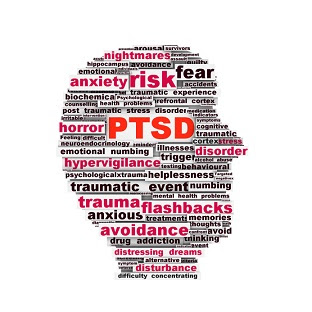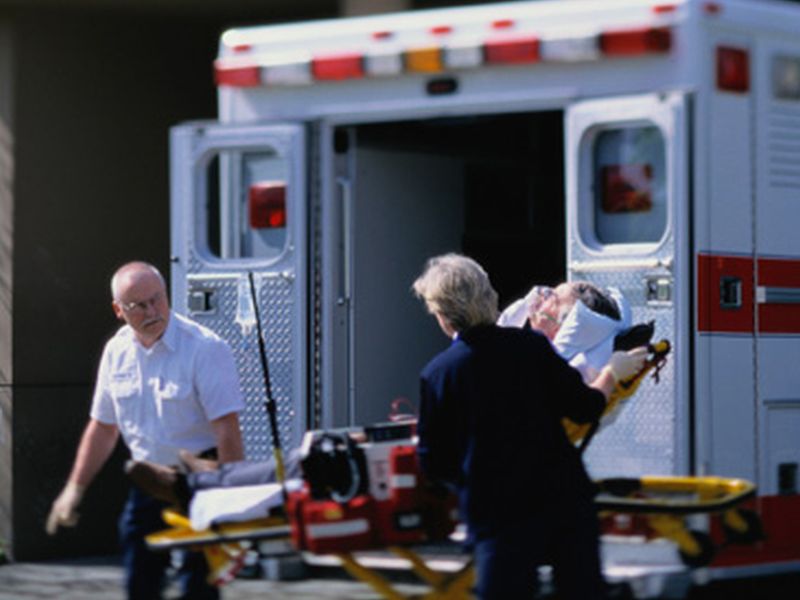You probably don't know why June 16, 2013, is a famous date in world of stroke survivors unless, of course, it's the date of your birthday or an anniversary, your friend or family's birthday, or, I'm sorry to say, the date of your stroke. Almost everybody remembers that!
But also on June 16, 2013, a startling discovery was released, linking post-traumatic stress disorder to stroke survivors. One in four have something else to add to their list, as if stroke isn't bad enough. And I am the one in four.
Post-traumatic stress disorder (PTSD) is an intense physical and emotional reaction to a traumatic or life-threatening event, typically associated with combat veterans and sexual assault survivors. Now, it's stroke survivors, too. If you're a stroke survivor having a problem obtaining disability benefits, this post may be the missing piece.
In fact, the study, published in the journal Public Library of Science, also discovered that people who had PTSD after a stroke could have a greater risk for heart problems or another stroke because of the physical, psychological, and emotional problems they must endure.
The study main honcho, Dr. Donald Edmondson, is an assistant professor of Behavioral Medicine at Columbia University Medical Center in New York City. He said the data showed that experiencing a stroke, or any other life-threatening condition, can pose grave physical, psychological, and emotional manifestations, thus, severe mental problems that often go unacknowledged by physicians and family members.
They were all there, those horrific PTSD symptoms. Depression, suicidal thoughts, laughing or crying when the situation called for the opposite response, rapid heart rate, frustration and anger over the smallest of incidents, nightmares, flashbacks, palpitations, chills, severe anxiety, irritability, difficulty sleeping, headaches, negative self-image, all or part can last a few months or even the rest of people's lives. I feel sorry for the military and rape victims who have PTSD, but welcome to the PTSD of a stroke survivor, too. I experienced all of those symptoms for 3 years. Now, 7 years post-stroke, I still get frustrated and anxious above the norm.
Said Dr. Edmonson, "We walk through our lives with the naive belief that we're invulnerable. Often what is traumatic is that such unspoken assumptions are broken. People must adjust to the shock of what has just happened. PTSD [in a stroke survivor] is a huge detriment to quality of life, a debilitating disorder in its own right, and deserves to be treated. There is something different about PTSD after a stroke because the threat is inside your body." Indeed it is.
But also on June 16, 2013, a startling discovery was released, linking post-traumatic stress disorder to stroke survivors. One in four have something else to add to their list, as if stroke isn't bad enough. And I am the one in four.
Post-traumatic stress disorder (PTSD) is an intense physical and emotional reaction to a traumatic or life-threatening event, typically associated with combat veterans and sexual assault survivors. Now, it's stroke survivors, too. If you're a stroke survivor having a problem obtaining disability benefits, this post may be the missing piece.
In fact, the study, published in the journal Public Library of Science, also discovered that people who had PTSD after a stroke could have a greater risk for heart problems or another stroke because of the physical, psychological, and emotional problems they must endure.
The study main honcho, Dr. Donald Edmondson, is an assistant professor of Behavioral Medicine at Columbia University Medical Center in New York City. He said the data showed that experiencing a stroke, or any other life-threatening condition, can pose grave physical, psychological, and emotional manifestations, thus, severe mental problems that often go unacknowledged by physicians and family members.
They were all there, those horrific PTSD symptoms. Depression, suicidal thoughts, laughing or crying when the situation called for the opposite response, rapid heart rate, frustration and anger over the smallest of incidents, nightmares, flashbacks, palpitations, chills, severe anxiety, irritability, difficulty sleeping, headaches, negative self-image, all or part can last a few months or even the rest of people's lives. I feel sorry for the military and rape victims who have PTSD, but welcome to the PTSD of a stroke survivor, too. I experienced all of those symptoms for 3 years. Now, 7 years post-stroke, I still get frustrated and anxious above the norm.
Said Dr. Edmonson, "We walk through our lives with the naive belief that we're invulnerable. Often what is traumatic is that such unspoken assumptions are broken. People must adjust to the shock of what has just happened. PTSD [in a stroke survivor] is a huge detriment to quality of life, a debilitating disorder in its own right, and deserves to be treated. There is something different about PTSD after a stroke because the threat is inside your body." Indeed it is.
Dr. Rafael Ortiz, director of the division of Neuroendovascular Disease and Stroke, Lenox Hill Hospital in New York
City, said, "This is the first time PTSD has been so closely
associated with strokes and TIAs [Transient Ischemic Attacks]. It's important that after suffering
from a stroke, people are taken care of by a comprehensive team of
doctors and other specialists, including psychologists and nurses who
are very well-trained."
And there it is, nestled in the words of the good doctor. Psychologists! Stroke survivors need psychologists, or psychiatrists, or licensed social workers to work with the pitfalls of having a stroke. In my perfect world, here is how it should go:
Assign a psychologist, psychiatrists, or licensed social workers to the patient immediately, to be there every day for the initial 2 weeks, weekly after that, to tell the patient how important it is to comply with all the health professionals, doing what they do--i.e., the nurses, doctors, therapists, even if you doubt them, and what the consequences are if you don't comply. Aah. That would have made all the difference to me who sometimes wouldn't comply. My right, dead arm might have moved, my right leg might have made me walk faster.
I saw a psychologist twice, a psychiatrist once, in my 15 weeks of rehab, and not initially. The hospitals say they don't have the money for the initial 2 weeks of counseling, weekly after that, yet the top officials of "said" hospital have their salaries going through the roof. It's the same way everywhere.
"Take a little less salary to initially afford psych teams," I would say, "and that will put your hospital first 'on the map,' with a psychological group the first 2 weeks that stroke patients are there." But alas, most stroke survivors don't care enough, and I don't blame them. That was me, 7 years ago, along with my family and ex-partner, with a lot more on our plates than we could handle.



















